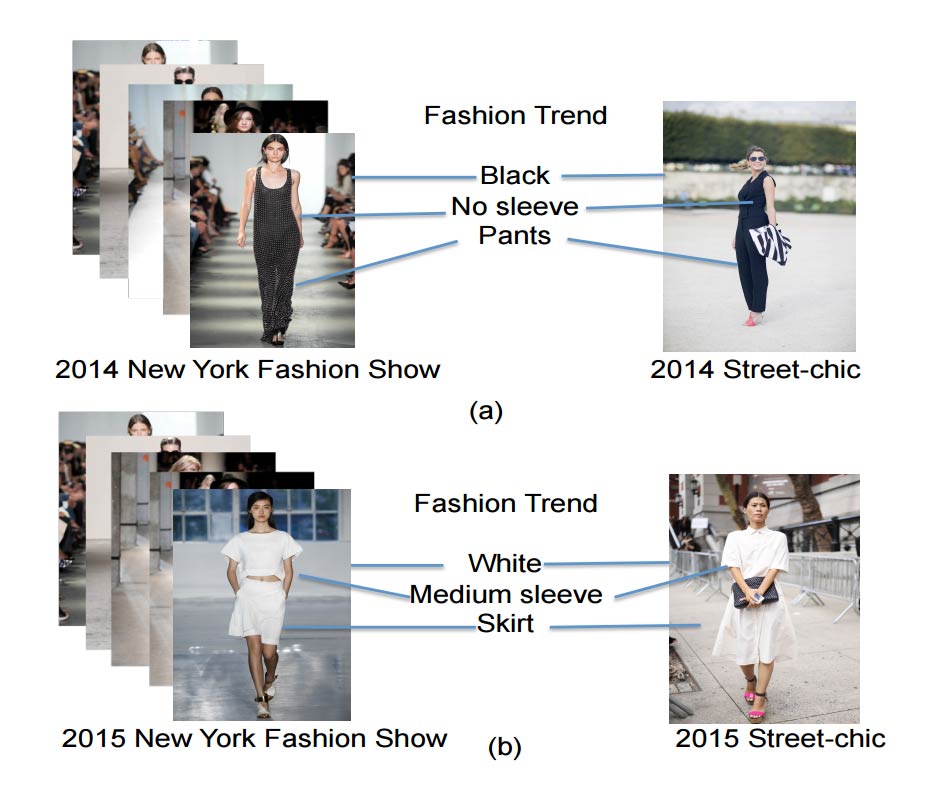How Machine Vision Is About to Change the Fashion World
In the 2006 film The Devil Wears Prada, the notorious fashion editor Miranda Priestly sizes up people at a glance by analyzing their clothes, who designed them, and what year they date from. Priestly’s character is famously inspired by Anna Wintour, the long standing editor-in-chief of Vogue, herself a style icon. –>

But if a human can recognize and date fashion styles with little more than a glance, why not a machine? Today, KuanTing Chen at National Taiwan University in Taipei and a few pals show that exactly this is possible—that machine vision can classify fashions and changes that occur from one season to the next. In particular, they use their machine vision techniques to show how trends in fashion shows influence street-chic outfits that appear afterward.
Chen and co begin by training their machine vision algorithm to identify an individual’s body pose in an image and then to divide the body into nine regions—the upper and lower arms and legs, and the torso. It then analyses the color, texture, skin, and so on for each of these areas to create a list that acts like a visual feature vector for the entire body.
Comparing fashion styles then boils down to the relatively simple mathematical process of comparing these 72-dimension vectors.
Next, they assemble two databases of photographs. The first contains 8,000 images of fashion models at New York Fashion week shows for the 2014 and 2015 spring/summer seasons. The second contains about 1,000 images of street-chic fashions taken during the spring and summer seasons in 2014 and 2015.
Fashion week is a significant event in New York. It consists of some 300 runway events attended by as many as 100,000 people. So an interesting question is how the trends that emerge during the week’s events go on to influence fashion on the street in the coming season.
To find out, Chen co use their machine vision algorithm to identify these trends and see how they influence street chic.
The results make for interesting reading. The algorithm found that a small number of classic outfit styles are common every year. “For example, in upper body color, both 2014 and 2015 fashion images have a large amount of white, grey, and black colors,” they say.
But a key point of interest is in how fashions change and the algorithm helps here too. It found that in 2015, more popular styles included placket and tank tops, and striped materials, and more popular colors were blue, cyan, and red for the upper body.
Interestingly, this change in popularity was echoed in the street-chic dataset. “We could tell that many people have the penchant to emulate clothing styles shown in the fashion shows,” say Chen and co.
There were also differences between the fashion week and street-chic data sets. For example, the team saw an increase in popularity of long knee wear and long sleeve wear in 2014 in street chic outfits. Chen and co speculate that must this must be the result of the particularly cold summer that year which encouraged people to wear warmer clothes covering more of the body.
That’s interesting work that shows how advanced machine vision has become in a relatively short period of time. That’s the result, at least in part, of improved body pose estimation algorithms that allowed limbs and other body parts to be identified quickly.
It also shows how cultural influences such as fashions spread quickly through society. “It seems clear that fashion trends from fashion shows indeed provide people with a clothing reference and have significant influence on people’s daily life,” say Chen and co.
Many followers of fashion will be intimately familiar with this. The difference now is that the effect can be quantified in a way that can provide valuable feedback to fashion houses, designers and consumers.
That’s likely to be a potentially profitable way to use machine vision. Miranda Priestly might just have been impressed.
Ref: arxiv.org/abs/1508.04785 : Who are the Devils Wearing Prada in New York City?
Keep Reading
Most Popular
Large language models can do jaw-dropping things. But nobody knows exactly why.
And that's a problem. Figuring it out is one of the biggest scientific puzzles of our time and a crucial step towards controlling more powerful future models.
How scientists traced a mysterious covid case back to six toilets
When wastewater surveillance turns into a hunt for a single infected individual, the ethics get tricky.
The problem with plug-in hybrids? Their drivers.
Plug-in hybrids are often sold as a transition to EVs, but new data from Europe shows we’re still underestimating the emissions they produce.
Google DeepMind’s new generative model makes Super Mario–like games from scratch
Genie learns how to control games by watching hours and hours of video. It could help train next-gen robots too.
Stay connected
Get the latest updates from
MIT Technology Review
Discover special offers, top stories, upcoming events, and more.